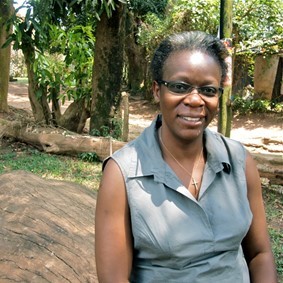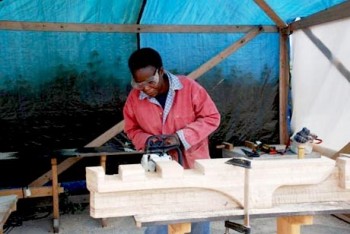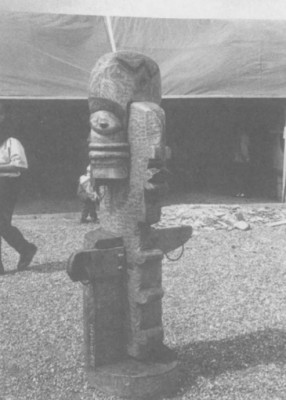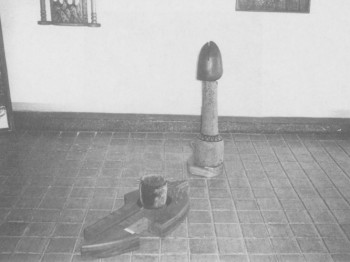Rose Nimubiru Kirumira (1962-)
Contemporary Ugandan sculptor, marrying together local and foreign sources of inspiration
Ugandan sculptor Rose Nimubiru Kirumira was born on 28 October 1962 in the Buganda Kingdom. Kirumira’s formative years coincided with the violence and upheaval of the Ugandan-Tanzanian war of 1978-1979 which ended Idi Amin’s presidency as well as the Ugandan Civil War of 1980-1986. Kirumira’s father fought for the Uganda Freedom Movement against the ruling President Milton Obote and was exiled to Kenya in 1982. To ensure their safety, Kirumira completed school separated from her family and reunited with her father after completing her A-Levels. Despite her father advising against returning to Uganda, she returned in 1983 where she began her Bachelor’s degree at Makerere University, Kampala. She later became the second woman to ever graduate with a Master’s degree from Makerere’s Art school.

From the 1960s, students and faculty at Makerere had been hotly debating the interactions between East African artists and ‘foreign’ art scenes, especially those located in Europe and North America. Artworks over the next decades implicitly and explicitly addressed the debate questioning whether embracing Western teachings and inspirations was to abandon East African cultural identities. By the 1970s and 1980s, in response to the tense political climates of Amin and Obote’s presidencies, art produced by Makerere students also addressed more local political controversies. Kirumira herself avoided the highly politicised path that many artists took during this period. She claims her work was not affected by harsh political realities as her art stood as a means of escapism to forget the hardships her family experienced. Instead, she remained faithful to her true inspiration of her local culture and investigated different ways to explore and immortalise cultural materials. Working in international arenas, she also seemed to avoid the conflict accompanying foreign art scenes. Throughout her career she has established access to networks both inside and outside of Uganda which undoubtedly have fed into her artwork and philosophy.
This debate of identity and foreign networks roots itself in conversations had by makers of contemporary African artistic and literary culture such as Elimo Njau, Ngũgĩ wa Thiong'o and Francis Nnaggenda from the 1950s onwards. As Sanyal summarises, artists were expected to recognise their post-colonial identity and negotiate the global character of the creative enterprise whilst denying the overarching colonial rhetoric of universalism and essentialism. Kirumira’s work finds balance in this debate, commanding her ‘global character’ through allowing international networks to influence her artistic process whilst maintaining her end-product as a clear representation of her local culture. Wa Thiong'o wrote of how an African author must sacrifice their local tongue to access global stages, whereas Kirumira communicates with the world without sacrificing her personal message. Her work and life are truly insightful to the Ugandan contemporary art world as they illustrate the ease with which she navigates balance between international and local stages showcasing her art throughout East Africa, Asia, Europe and Canada.
Early career and the Triangle Network

One of Kirumira’s first on-ground experiences outside of Makerere was at an international artists’ workshop at the Thapong Visual Arts Centre, Botswana, in 1994. This was organised by the Triangle Arts Trust (now known as the Triangle Network), an organisation founded in 1982 by Sir Anthony Caro and Robert Loder. The network brought together artists from the USA, Canada and the UK but soon expanded to connect artists across Africa. The organisation hosted two-week workshops where artists from diverse cultural backgrounds could engage, explore and expand the boundaries of their practice. They aimed to counterbalance the emphasis the Western art world puts on an object and its marketing rather than on the creative process itself. Kirumira’s engagement with the Triangle Arts Trust saw her marry Western visual art skills with her local shapes, colours and designs and connected her with artists across the globe.
After finding inspiration at the Triangle workshop and seeing how international art networks could benefit one’s art process without interfering with the local focus of an end product, Kirumira initiated the Ngoma International Artist’s workshops and in 1997, hosted the first-ever international artists’ workshop in Uganda. The Ngoma workshop was conceived as a space where artists, whether academically trained or not, could experience intensive professional rejuvenation. Similar to the Triangle Arts Trust, the workshop served as a space where new ideas and styles could be exchanged to birth fresh artistic activity within the region and African artists could raise their profile to the international stage. Not guided by formal procedures of art institutions and education, Kirumira enabled artists to reflect on individual expression within contemporary artistic practice and confidently develop patronage to a new network that she was helping to create in Uganda. Kirumira’s approach chimed with the art history and artistic production disputes of 1960s Makerere surrounding the importance of Art being taught as an academic discipline, as it was in Europe. In the 1960s, figures such as Jonathan Kingdon and Cecil Todd argued that knowledge of composition, techniques and design was compulsory in forming a ‘credible’ artist. Opposing this were the likes of Francis Nnaggenda, who later trained Kirumira. She summarises his teachings stating that he believed “as an artist, you do what you feel” and by putting yourself into your work, your “traditional you” will naturally appear. These teachings moulded Kirumira’s philosophy and her workshop broke new ground in this ongoing debate; initiating a wave of self-made artists who were versatile, confident and not relying on professional academic training to find their own genuine, individual expression.
Navigating global and local stages

Through her diverse in-country experiences in South Africa, Zambia, Tanzania, Denmark, China, Kenya and Botswana, Kirumira gained an understanding of the cultural differences which separates us and common ground which unites us. Her work often encapsulates her Ugandan and non-Ugandan influences, however pieces such as ‘Omumbejja’ (1997) highlight the common realities of African artists attempting to gain access to global conversations. After being rejected from an international sculptors’ symposium in Denmark, she was invited the following year where she made her sculpture ‘Omumbejja’ (meaning ‘Princess’ in Luganda). Here, other artists were surprised to see an educated African woman wearing jeans and working power tools as this was not the ‘traditional African artist’ that they hoped for. Western stereotypical narratives over the postcolonial period claimed that African artists had a “born sense of colour, rhythm and design” which was evident in their work: Aware of these expectations Kirumira was sure to add certain characteristics into her sculpture that rung true to Western perception of African art in attempts to gain space on this Western stage. Her manipulation of Western expectation is a particularly interesting example of how contemporary African artists are asked to sacrifice their authentic individual expression in order to access non-African contemporary art scenes.
However, when making art for art’s sake Kirumira continues to interact with both local and foreign stages, such as in her sculpture ‘Kintu and Nambi’ (1997), a piece forming of two sculptures that references the mythic hero Kintu (the first person on earth according to the Kiganda myth of creation) and his partner Nambi. As analysed by Sanyal, Kirumira builds upon existing sexual symbolism that exists in other cultures surrounding the two domestic objects of the pestle and mortar, the pestle is illustrated as the phallus and the mortar as the vulva.

This sexualisation of two household objects can be read as Kirumira’s attempt to empower Muganda women by altering the identities of two otherwise mundane tools from the women’s sphere. However, through the utilisation of these exact ‘mundane’ tools Kirumira also traverses the global plain as the mortar and pestle are by no means unique to Buganda but are objects found in cultures across the globe. Varying from culture to culture, they are symbols of sustenance, fertility and procreation which adds to the empowering sexual symbolism created for Muganda women. Through symbolism, this piece occupies a clear position on the global art stage, however, through its title, it is immediately localised to Buganda, simultaneously occupying the local stage. Through establishing this connection between the two worlds, Kirumira creates space within the contemporary art debate for disappearing traditions, history and heritage and indicates relationships between the past and present; she represents the continuum of existence and does so through material culture.
Where to place her?
Too often a narrative of opposition surrounds the relationship of the local and the global, Kirumira’s careers sees a marriage of these two stages and inspires the questioning of African Art frameworks. What is the most suitable way to frame East African Art during the twentieth century? Parallels can be drawn between colonial frameworks and the frameworks of ‘pre-Trowell’ (the founder of Makerere’s Art school), ‘Trowell’ and ‘post-Trowell’ education. Even within the ‘post-Trowell’ segment that Kirumira falls under, art is often fractioned by political leaders as Ben Enwonwu claims that “every true artist is bound… to express, even unconsciously, the political aspirations of his time”. Kirumira’s work defies these labels and although she believes art to be a powerful instrument for creating socio-political awareness, her work was not consumed by the highly politicised narratives of the late twentieth century. Moreover, Kirumira speaks well to the sentiment of art defying the constraints of space and time, she creates conversation between old traditional and contemporary art, rightfully asserting her culture as well as herself as a female Ugandan artist a place in the global contemporary art discourse.
Archives and online sources
- Transition Magazine archive: https://www.jstor.org/journal/transition
- Dr Rose Kirumira, http://www.rosekirumira.net/
- The Triangle Network, https://www.trianglenetwork.org/
- “The Special One: An Interview with Rose Kirumira”, interview conducted by Thomas Bjørnskau (2011), published on The Start Journal magazine of Contemporary Arts & Culture in East Africa https://startjournal.org/2011/03/the-special-one-an-interview-with-rose-...
Further reading
- Kakande, Angelo. “Contemporary Art in Uganda: A Nexus between Art and Politics.” PhD thesis, University of Witwatersrand, Johannesburg, 2008.
- Sanyal, Sunanda. “Transgressing Borders, Shaping an Art History: Rose Kirumira and Makerere’s Legacy.” Matatu: Journal for African Culture and Society 25-26 (2002): 133-159.
- Sanyal, Sunanda. “Being Modern: Identity Debates and Makerere’s Art School in the 1960s.” In A Companion to Modern African Art, edited by Gitti Salami and Monica Blackmun Visona, 255-275. England: John Wiley & Sons, 2013.
- Sanyal, Sunanda. “Imaging Art, Making History: Two Generations of Makerere Artists.” PhD thesis, Ohio University, 1993.


